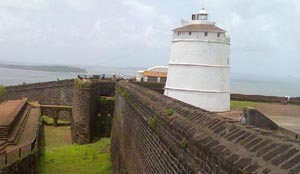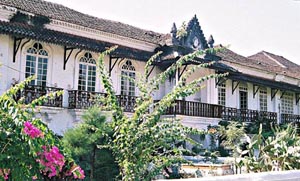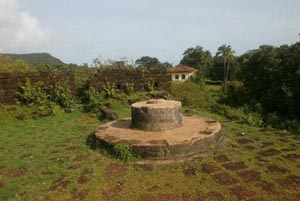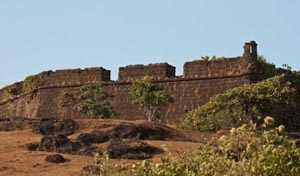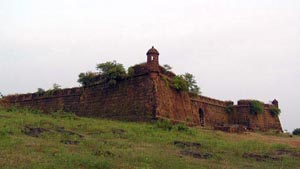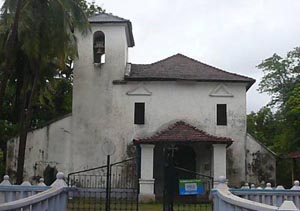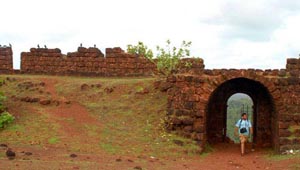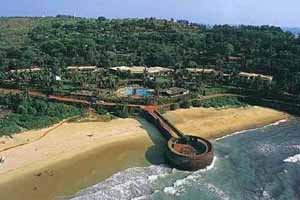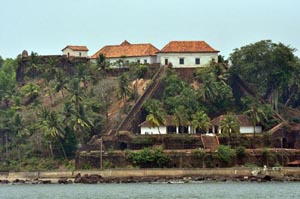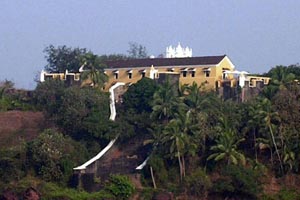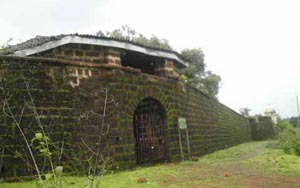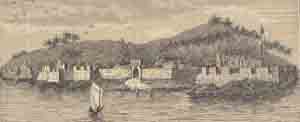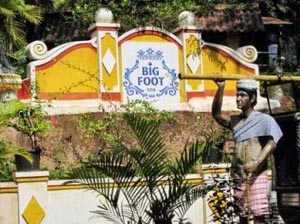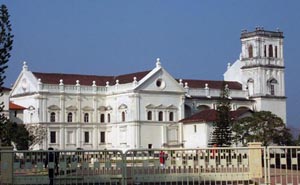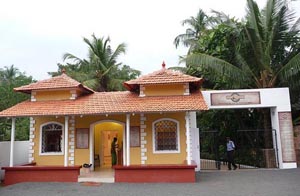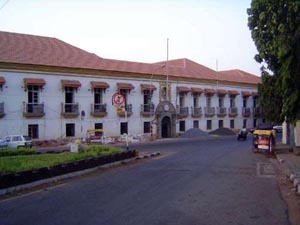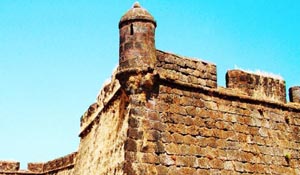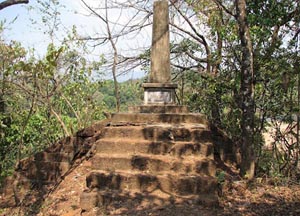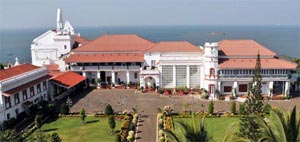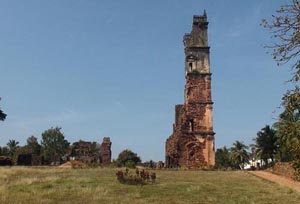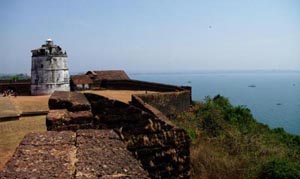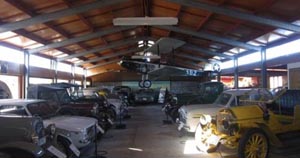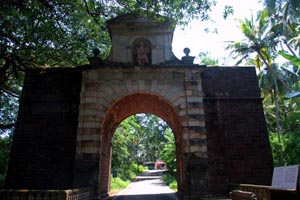Goa Monuments - Famous Historical Places, Forts & Palaces
List of names of Famous Historical Forts / Palaces / Places of Goa State
Here you can find list of names and information on historical forts / palaces/ places / monuments in Goa, India. These famous monuments of Goa state are most visited and most sought after best tourist places. You can also find images of Goa monuments / places / forts / palaces.
The monument i.e. Fort Aguada is a seventeenth-century structure located in Goa, India. Specifically the fort is located in the Sinquerim Beach which is near to the Arabian Sea. The fort is one of the most well preserved of the rich Indian history. Its architectural splendor and the historical importance makes it one of the renowned forts of Goa, which has preserved rich historical and cultural significance of the era gone by.
The Menezes Braganza Pereira is a house that is located in the Chandor village of Goa. It has a history of more than 350 years old and it is one of the oldest structures located in Goa. The rear end of the house has the church square in Chandor. It is one of the most exquisite house in Goa in terms of its historical heritage.
The fort Cabo de Rama is located in Goan beach. The fort is named after the Hindu God Lord Rama. The fort is specifically located in the Canacona district of Goa. It is positioned at 25 km to the southern end of the Margao region. While talking about this historical fort, it contains huge importance when it comes to history of Goa as well as the importance it has shaped the Goa and the days that was once ruled by the Portuguese.
The monument was recorded in the history books to have built during the year 1510. During this particular period, the place i.e. Goa was under the rule or influence of the Portuguese rulers. The structure of the fort has witnessed several transformations after the Portuguese intruders acquired the Bardez region. Notably, history suggest that with the intention to end the rule of the Portuguese in Goa, famous king Akbar join hands with the enemies of his family i.e. Marathas during the late 16th century.
Corjuem Fort is one of the oldest Portuguese Fort located on the island of Corjuem in Goa. The Fort is at a distance of 4 kilometers from the Aldona village. The fort is famous for its rich cultural heritage. The small size of the fort makes it more appealing and signifies its importance in the history of Indian cultural heritage. The fort is about 12 kilometers away from the main city of Panjim and is surrounded with natural beauty i.e. greenery and rivers.
The fort was built with the incorporations of the Hindu architectural style but in the later changes has been made in the fort under the rule of the Portuguese following the Portuguese style of architecture. Though most parts of the fort has ruined, the remaining section of the fort shows some brief about its architecture and history. The church inside the fort was made following the Baroque style of architecture.
The fort has the influence of the Portuguese and Hindu architecture. During the stay of the Marathas in this particular fort, they have redesigned some parts of the monument based on the local architectural style. Though most parts of the fort are ruined, its structural importance can still be comprehended. There are lot of tress within the fort which makes it a soothing place in terms of environment. The fort was primarily made of brick and stone along with mud.
The fort was mainly built following the Portuguese style of architecture. However, in the later scenario, it was redesigned by the Maratha rulers owing to which some parts of the fort also depicts the Hindu style of architecture. Inside the fort there are magazines, chapel and quarters for the guards which were mainly placed during the rule of the Portuguese in the fort. Another important feature of the fort that adds to its beauty is the fountain that is located in the center of the fort.
The architecture of the fort has the fusion of the Hindu and Portuguese style of architecture since it was designed several times under the rule of the Portuguese and Marathas among others. The Reis Magos fort was bounded with laterite walls in the entire exterior. From the height in which fort is built, one can splendid view of the surrounding area. The fort is preserved well over the years. Artifacts of more than 33 guns can be found within the fort in the present day context.
The fort was made in a way where one can witness the beauty of the Arabia Sea standing in it. The fort was built following the Indian style of architecture. Though most part of the fort has deteriorated over the years but with the Portuguese rebuilding it in the later history, the beauty of the fort has still remained intact. It is one of the most well preserved forts in the history of Goa. The Holy Trinity church built within the fort followed the British style of architecture.
Alorna Fort, which is also termed as 'Halarn Fort', is one of the eldest fortresses in Goa. It is located in Mapusa town of Goa. Alorna Fort was created by Bhonsles, a protuberant warrior clan who ruled several states in India. The fort was established during 17th century for safeguarding against the assaults from Maratha rulers. Alorna Fort provides great sight of the nearby river and land. However, at present the fort has become an abandoned place and is occupied with wild vegetation.
Anjediva Fort is one of the popular forts of Goa. It is situated in Anjadip Island whichis located in the boundary of Goa. This fort is also known as Anjadiva Fort or Anjediva Fort which was created by Portuguese rulers during the year 1505 AD. Once ruled by Portuguese people, Anjediva Fort has presently become a ruined construction.
Bigfoot Art Gallery is also termed as 'Ancestral Goa' which is a popular museum situated in Majorda Beach of Goa. Apart from museum, Bigfoot Art Gallery is also a theme park which demonstrate the inherited Goa village. In simple terms, Bigfoot Art Gallery is a phantasmagoria of Goa's rural life which depicts the usual functions of traditional Goan village. Bigfoot Art Gallery holds various objects and arts of ancient times.
Created in the year 1994, 'Museum of Christian Art' is regarded is the first museum of its kind in the whole Asian continent. The museum was initially located in Institution of Rachol in Salcette of Goa, however, at later phase it was repositioned in the monastery of Santa Monica of Old Goa. Museum of Christian Art displays the richness of Indo-Portuguese Christian talent. It also highpoints a portion of Goa's tradition that was abandoned and would have been gone if not well-maintained.
Goa Chitra Museum is regarded as an ethnographic museum which is situated in Benaulim of Goa. It possess significant collection of about 4000 artefacts which are based on Goa's traditional agricultural skill and standard of living. The museum was founded in the year 2010 by artist as well as custodian, Victor Hugo Gomes. Due to its unique collection, Goa Chitra Museum is considered as one of the most charming attractions in Goa which houses various outdated objects and tools which have developed over centuries.
Idalcao Palace which was also known as Adil Shah Fort is regarded as one of the oldest surviving forts in Goa. The palace is situated in the capital of Goa, i.e. Panjim or Panaji at the bank of Mandovi River. Idalcao Palace was created in the year 1500 by Yusuf Adil Shah as a waterside pleasure. Later, the palace was reinvigorated and served as a strategic security point for Portuguese people. They further developed the military strength of the palace.
Located within the distance of about 4 kilometre from Aldona of Goa, Khorjuve or Corjuem is an island where Khorjuve Fortress is based. The fortress was constructed in 1551 by Bhonsles rulers and it is quite small in comparison with other fortress of Goa. Irrespective of the size, Khorjuve Fortress provide great sight of the nearby river and land. The dimension of the fort opposes its strategic significance in Goa's history.
Nanuz Fort which is also known as Nanus Fort is one of the popular historical places to observe in Goa. This historical specimen was created in 17th century by Maratha emperor Shivaji. Initially the fort was created for defence purposes and accordingly changed by the rulers' mechanism. The fort is situated in Satari Taluka, near Valpoi village of North Goa.
Situated in the south point of river Mandovi and at the great end of Arabian Sea, Raj Bhavan is one of the monuments of historical and architectural importance of Goa. Raj Bhavan is known as various other names such as Cabo Palace or Cabo Raj Niwas which was created in 1540 AD. Traditionally, throughout the Portuguese command, Raj Bhavan was regarded as the authorised house of the governor general.
The St. Augustine Tower or St. Augustine Church is one of the ancient cathedrals of Goa. It was created in the year 1602 AD by twelve Augustinian monks. Miserably at present, the church along with the adjoining convent have become ruins owing to the prohibition on religious instructionsdelivered by the Portuguese government. The only significant remains of St. Augustine Church is a tall tower without the church bell.
Sinquerim Fort is one of the biggest and inspiring forts conserved and is one of the famous landmarks of Goa's history. The fort is situated within a distance of 18 kilometre from Panaji. Created in the year 1613, Sinquerim Fort is an extension of Aguada Fort. The fame of the fort has augmented from the fact that its cliff on which it was created provides a delightful sight of military architects.
Vintage Car Museum is among the popular museums in Goa which is devoted to reinstate and to reserve the riding and motorcycling charms of Goa's history. It ranges variety of vehicles, ranging from Mercedes Benz to Chevrolet and Volkswagen among others. Situated in Nuvem town of South Goa, Vintage Car Museum is regarded as Goa's first car gallery and outlet.
The Viceroy's Arch is a vital and ancient specimen of Goa's pride. It was created in the year 1599 by Viceroy Francisco da Gama. Viceroy's Arch was created for the honour of Vasco da Gama, the renowned explorer. It was the primary way for entering Old Goa. Viceroy's Arch is also known to have been one of the entrances towards entering Adil Shah's palace. The structure of the arch represents an acknowledgement to the accomplishments of Vasco da Gama.
- Andaman Nicobar Monuments
- Andhra Pradesh Monuments
- Assam Monuments
- Bihar Monuments
- Chhattisgarh Monuments
- New Delhi Monuments
- Goa Monuments
- Gujarat Monuments
- Haryana Monuments
- Himachal Pradesh Monuments
- Jammu and Kashmir Monuments
- Karnataka Monuments
- Kerala Monuments
- Madhya Pradesh Monuments
- Maharashtra Monuments
- Odisha Monuments
- Punjab Monuments
- Rajasthan Monuments
- Tamil Nadu Monuments
- Telangana Monuments
- Uttar Pradesh Monuments
- West Bengal Monuments
